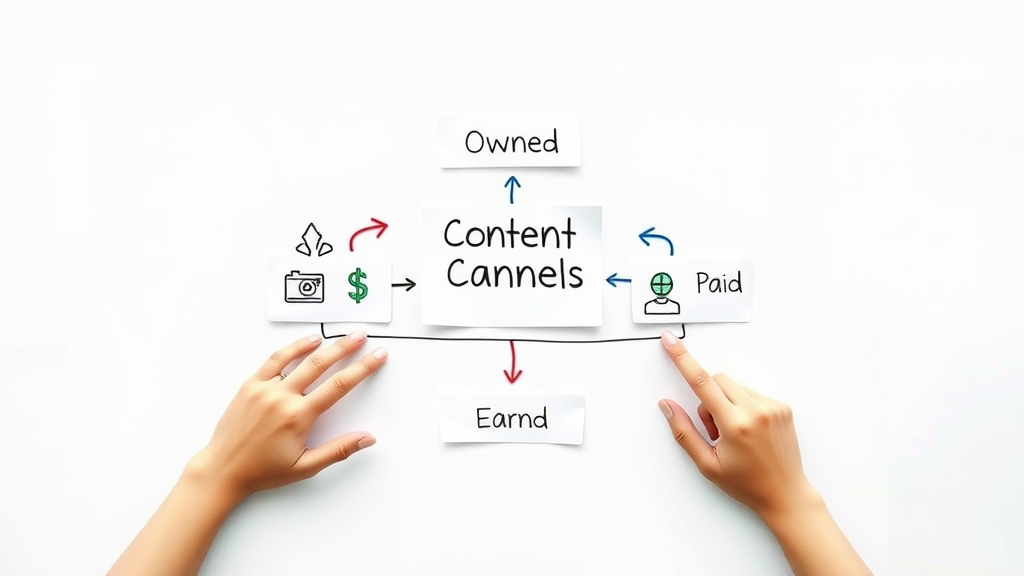Did you know that over 60% of marketers admit they underutilize at least three major content distribution channels? While most brands focus on social media and their own blog, an entire world of high-impact distribution options remains untapped. In today’s competitive digital landscape, relying on just a handful of platforms means limiting your growth potential—and letting competitors get ahead. If you’re ready to explode your reach, boost your content ROI, and discover new audiences, it’s time to rethink your content distribution strategy . Let’s dive into the hidden gems and proven winners of modern content distribution channels .
Unlocking the Power of Content Distribution Channels with Surprising Industry Facts
- Did you know that over 60% of marketers admit they underutilize at least three major content distribution channels? Discover what you’re missing, and how diversifying your content distribution strategy can dramatically boost your ROI and content marketing results.

Marketers today face tremendous pressure to justify content budgets and show real results. Yet, a recent study reveals most are missing key opportunities simply because they stick to the obvious. When you diversify your distribution channels , your brand can connect with a wider target audience , power up brand awareness, and see bigger returns from content creation efforts. Whether you’re B2B or B2C, expanding your channel mix is proven to increase visibility, engagement, and conversions, all while future-proofing your strategy against platform changes or algorithm shifts. In the following sections, you’ll unlock expert insights, action steps, and real-world tips to make your content go further—without breaking the bank.
Content Distribution Channels Explained: The Foundation of Modern Content Marketing
What is a Content Distribution Channel?

A content distribution channel is any platform or method used to share your content with a broader audience. From your own blog and email newsletter to high-traffic media platforms and paid content partnerships, each channel offers a distinct way to reach diverse audiences. Unlike just publishing on your website, true distribution means strategically placing content where your readers already spend time. The goal? Maximize every piece of content’s exposure, drive qualified traffic, and multiply conversions. Understanding these channels—and where your unique audience frequents—lies at the heart of successful content marketing .
Modern distribution strategy is a blend of owned, earned, and paid channels, each with unique strengths. Owned channels, like your website and social media, offer control. Earned channels, such as PR and organic shares, offer credibility. Paid channels, like sponsored content and paid social, provide scale and targeting. Mastering which to use and when is the first step to amplifying your message and ensuring it reaches far beyond your core followers.
The Role of Content Distribution in Your Content Marketing Strategy
While content creation often gets the spotlight, even the most valuable blog posts or videos fall flat without a smart distribution strategy . Effective content distribution channels act as multipliers—turning a single blog post into widespread brand awareness, qualified leads, and ongoing engagement. The right mix of channels also helps you tailor each message for the specific platform and audience, leveraging the organic strengths of each to boost impact. Over time, tracking how each channel performs allows marketers to refine their approach, invest in what works, and cut what doesn't—turning content distribution into a repeatable engine for growth.
With today’s data-driven tools, you can experiment with media platforms beyond the obvious: think expert forums, aggregators, community-driven groups, podcasts, and influencer collaborations. By mapping your content types to the right distribution channels, you set the stage for measurable improvements in traffic, engagement, and ROI. In the sections ahead, we’ll break down core categories, reveal underused gems, and help you shape a modern, resilient distribution game plan.
What You’ll Discover in This Guide to Content Distribution Channels
- Clear definitions and distinctions between various content distribution channels
- Innovative but underutilized distribution channels you should consider
- Practical steps to refine your content distribution strategy
- Real-world examples, expert insights, and actionable checklists
Types of Content Distribution Channels: Core Categories and Emerging Leaders
Exploring Owned, Earned, and Paid Distribution Channels
| CATEGORY | DESCRIPTION | EXAMPLES |
|---|---|---|
| Owned Channels | You control the platform/audience | Blog, email newsletter, website |
| Earned Channels | Others amplify your content organically | PR, guest blog posts, reviews |
| Paid Channels | Platforms you pay to reach an audience | Sponsored content, paid social, native ads |

At the highest level, content distribution channels come in three major types: owned, earned, and paid . Owned channels are fully under your control, providing the most reliability and flexibility—think your company blog, website, or email newsletter. Earned channels leverage third-party praise, media coverage, or organic shares, often producing the highest trust but the least predictability. Paid channels encompass any platform where you invest money for exposure—social ads, sponsored content, or native ads being prime examples. Each of these categories intersects, creating a robust ecosystem that maximizes your reach when used in harmony.
To build sustainable traffic and growth, brands need to balance these channel types. While owned channels foster brand loyalty and recurrence, earned channels drive credibility and wide network effects. Paid channels offer laser-focused reach and quick traction. The trick? Evaluate which mix best serves your target audience and business goals, then tweak based on continuous analytics monitoring. In fast-changing digital environments, flexibility and channel diversity provide lasting advantage.
Three Types of Content Distribution Channels Explained
Let's break down why owned, earned, and paid channels are essential parts of an integrated content distribution strategy . Owned channels excel at nurturing long-term customer relationships—blog posts and newsletters offer direct, measurable engagement. Earned channels supercharge reach; a mention in a respected industry publication can spike traffic and boost SEO for months. Paid channels, meanwhile, allow for precision targeting, scaling content quickly, and reaching audiences your owned efforts might miss. The best brands weave all three types together, often customizing content types or messages for each channel’s unique context. This hybridized approach not only increases exposure but also ensures brand messaging is cohesive while maximizing content ROI across the board.
Rethinking Popular Content Distribution Channels: Are You Using These to Their Full Potential?
Social Media Platforms: More Than Facebook and LinkedIn

Most brands default to Facebook, Twitter, and LinkedIn when it comes to social sharing, but the universe of social media platforms is rapidly expanding. Niche networks like Reddit, Quora, and specialized forums offer highly engaged audiences where thought leadership and educational content types thrive. For B2B brands, platforms like Stack Overflow or industry-specific groups can yield deeper conversations than viral-focused giants. Instead of blasting every media post to all platforms, selectively crafting messages for the unique tone and audience of each channel produces higher engagement and more shareable content.
Try leveraging new and emerging platforms where your competitors aren’t yet active. For instance, participating in topic-focused subreddits or answering relevant Quora questions can build both authority and exposure for your brand. Monitor analytics to find which platforms drive traffic and engagement for each content type , then double down on those winners.
Leveraging Blogging and Blog Posts as Powerful Owned Channels
Your blog remains an invaluable owned channel . High-quality blog posts are foundational assets that not only drive traffic from search engines, but also provide rich raw materials for repurposing and distribution. Each blog post, when strategically interlinked and promoted, helps build site authority and cultivates a loyal readership. To get maximum value, focus on timely topics, address niche industry themes, and include actionable tips or expert perspectives that prompt shares and backlinks across media platforms .
Don’t just publish and wait—repurpose blog posts into infographics, videos, and social media content to distribute across other content distribution channels . Capture leads via embedded forms, and encourage discussions through embedded comments or targeted email follow-ups for each blog post . This multi-format, multi-channel approach maximizes the reach and impact of every article you create, while also fueling your SEO and brand-building efforts.
Unlocking the Value of Email Newsletters and Email-First Distribution Strategies

Email newsletters remain one of the most direct and measurable content distribution channels . They offer unique access to your target audience without reliance on shifting third-party algorithms. Email-first strategies mean prioritizing newsletter content, using segmentation to tailor messages to specific subscriber interests, and ensuring each campaign delivers real value. Unlike fleeting social media posts, emails land directly in your audience’s inbox, fostering personal relationships and nurturing leads over time. The key to success is delivering consistent, relevant content and clear calls to action—prompting recipients to share your content, complete offers, or engage further with your brand.
For maximum impact, experiment with new formats such as curated industry roundups, exclusive offers, or interactive elements within your email newsletter . Analyze engagement rates to continuously refine topics, sending frequency, and layout. Over time, an engaged email list becomes an engine for recurring traffic, product launches, and even earned media coverage as your content gets shared organically.
Underused Content Distribution Channels: Tactics the Competition Hasn’t Tried
Content Redistributors: Expand Reach with Aggregators and Syndication Networks

One of the most overlooked tactics in content distribution is leveraging content aggregators and syndication partners. Websites like Medium and Flipboard, as well as categorized content redistributors, can amplify your blog posts or articles to wide, highly targeted audiences. Platforms such as Business 2 Community, GrowthHackers, or industry-specific syndication networks help republish your content to new reader segments far beyond your core followers. This exposes your brand to fresh prospects and may yield valuable backlinks, citations, and influencer shares. Aggregators also allow for intelligent targeting based on post tags, format, or vertical, making them a potent addition to any modern distribution strategy .
A best practice is to submit high-performing blog content or evergreen thought leadership pieces that are likely to resonate with aggregator audiences. Always monitor analytics to gauge referral traffic, audience engagement, and conversion rates from these redistributors—then optimize your approach based on which platforms yield the best ROI.
Community-Driven Distribution Channels: Forums, Groups, and Direct Engagement

Online forums and community groups represent a powerful channel often ignored by mainstream marketers. Platforms like Reddit, Slack communities, industry Facebook groups, or Discord channels are places where your target audience shares problems, advice, and recommendations in real time. By participating authentically—adding value to discussions, sharing relevant insights, and answering direct questions—brands foster trust and build authority. Rather than blasting the same media post everywhere, adapt your message and interaction style to each specific group’s tone and expectations.
Don’t treat these spaces as promotional outlets. Instead, give before you ask: contribute resources, offer solutions, and only share your own content when it truly adds to the conversation. Over time, you’ll earn relationships that make your future content shares more welcome—and more effective—than clumsy self-promotion ever could.
Partnership and Influencer Collaborations: Turning Earned Media into a Scalable Distribution Channel
Influencer partnerships and brand collaborations remain underutilized as reliable content distribution channels . By working with subject matter experts, respected industry voices, or non-competing companies, you can tap directly into their audiences and credibility. Co-creating blog posts, running joint webinars, or sharing curated content in newsletters can transform earned media into a scalable, ongoing source of new leads and engagement. Influencers bring authenticity and reach; partnerships provide scale and niche access—especially when launching new products or entering new markets.
To maximize results, set clear mutual goals, define your target audience , and use UTM tracking to monitor performance. Leverage both parties’ owned channels for co-promotion, and consider following up with paid retargeting or email campaigns to nurture new contacts gained through these efforts.
Next-Level Content Distribution Strategy: Integrating Paid and Organic Distribution Channels
Combining Paid Content Distribution with Social and Owned Channels

Leading brands understand the power of integrating paid content distribution with strong organic and owned channel efforts. Running sponsored content campaigns through platforms like Outbrain or Taboola, or using paid social ads on Facebook, Instagram, or LinkedIn, enables you to amplify high-performing blog posts, videos, or lead magnets quickly. The most effective approach, though, is to use paid tactics to test, scale, or retarget audiences after organic traction is proven. By always aligning paid campaigns with organic strategy and leveraging data from both, you maximize your spend and reach without duplicating effort.
Make sure your creative and messaging remain consistent across all touchpoints. Use analytics to determine which combinations of channels drive the highest-quality leads or conversions, and allocate budget accordingly for peak performance.
Distribution Channel Analytics: Measuring the Success of Your Content Distribution Strategy
Tracking the effectiveness of your content distribution channels is essential for continual growth. Key metrics include referral traffic, time on site, lead generation rates, conversion rates, and ultimately ROI for each channel or campaign. Robust tools such as Google Analytics, Sprout Social, or SEMrush make it easy to visualize which platforms bring engaged users—and which need improvement or reconsideration. Go beyond vanity metrics: Focus on sources that not only generate clicks but nurture successful content outcomes, such as downloads, registrations, or sales.
Regular analytics reviews foster a culture of accountability and learning. Document your findings after each campaign or quarter: Which distribution channels exceeded expectations? Which ones need refining or replacement? A data-driven mindset ensures your distribution efforts evolve along with your audience and business goals.
Crafting a Content Distribution Strategy That Fits Your Brand and Target Audience
Mapping Content Types to Optimal Distribution Channels

The most effective content distribution strategy tailors each content type —whether articles, videos, podcasts, or infographics—to the distribution channel where it will perform best. For example, in-depth guides or blog posts fit well on your owned channels and organic search, while visually rich content and quick tips are ideal for social media platforms. Videos shine on YouTube, TikTok, or Instagram, while webinars or e-books can be promoted through email and niche forums.
Start by auditing your existing content library, then map each major asset to platforms where your target audience is most active and engaged. Experiment periodically with new formats—such as short-form video, interactive polls, or co-branded media posts—to discover new high-potential channels for expansion.
Identifying and Segmenting Target Audiences Across Distribution Channels
Success in content marketing depends on knowing precisely who you want to reach, and segmenting your target audience across channels. This means creating personas for each major stakeholder group, understanding where they spend their time, and adapting both the content and delivery method accordingly. For instance, business decision-makers may prefer in-depth articles on LinkedIn, while younger demographics might engage on Instagram Stories or TikTok. B2B marketers often get better traction on forums, Slack groups, and webinars, whereas B2C brands might prioritize influencer partnerships or visual content platforms.
Use analytics, surveys, and direct audience feedback to refine your approach over time. Deploy A/B testing on subject lines, visuals, and CTAs across paid and organic channels. The more tightly segmented and personalized your distribution plan, the higher your engagement—and the stronger your results from each content piece you create.
People Also Ask: Key Distribution Channel Questions Answered
What is a content distribution channel?
A content distribution channel is any platform, service, or method used to share your content with audiences beyond your website. Examples include social media platforms, blog syndication sites, email newsletters, paid media, and niche industry forums. The purpose is to maximize your content’s reach and impact by meeting prospects where they already engage.
What are the 4 distribution channels?
The four main types of distribution channels are: Owned Channels (your website, blog, email list), Earned Channels (PR, organic shares, guest posts), Paid Channels (sponsored content, paid ads, native ads), and Shared Channels , often considered a subset, referring primarily to social channels and collaborative partnerships. Each type serves a unique role in amplifying your brand’s visibility and reach.
What are the three types of content distribution channels?
The three primary types are: Owned channels (platforms you control, like websites and email), Earned channels (external platforms amplifying your content without payment), and Paid channels (platforms you pay to reach an audience, such as social ads and sponsored content). Successful strategies often blend all three for maximum scope and impact.
What is a content redistributor?
A content redistributor is a platform or service that republishes or aggregates existing content from other sources. Examples include Medium, Flipboard, and industry-specific syndication networks. By leveraging content redistributors, your brand can extend content reach to new audiences and boost traffic beyond your usual channels.
Case Studies: Successful Content Distribution Channel Strategies
How XYZ SaaS Used New Distribution Channels to Increase Blog Traffic by 200%
"Utilizing unexpected distribution channels helped us double our inbound traffic in less than six months." – Head of Content Marketing, XYZ SaaS
XYZ SaaS recognized that core channels—like SEO and standard social media—were no longer delivering exponential growth. They invested in syndicating blog posts through platforms like Medium and GrowthHackers, while also participating in curated Slack communities and running targeted sponsored content on niche industry sites. Through this expansion, their content distribution strategy saw a rapid increase in traffic, higher engagement, and more leads, proving the ROI of diversifying beyond the usual suspects.
Video Example 1: Measuring Impact of Distribution Strategy across Multiple Channels
Building Your Scalable Content Distribution Strategy: Actionable Steps and Tools
- Audit your current distribution channels for performance gaps
- Identify underused channels with growth potential
- Develop content tailored to new platforms
- Set clear KPIs for each distribution strategy
- Regularly review analytics and pivot as needed
Video Example 2: Integrating Owned and Paid Distribution Channels for Explosive Growth
Toolkits and Resources for Smarter Content Distribution Channel Management
- Content distribution platforms: Outbrain, Taboola, Medium
- Analytics tools: Google Analytics, SEMrush, Sprout Social
- Email automation: Mailchimp, ConvertKit
- Community management: Slack, Reddit moderation tools
Video Example 3: Comparing Tools for Multi-Channel Content Distribution
Avoiding Common Pitfalls: Mistakes to Watch Out For with Content Distribution Channels
- Relying solely on a single distribution channel
- Ignoring analytics when refining your distribution strategy
- Failing to personalize content for each target audience
- Neglecting earned channels in content marketing

Expert Insights: Quotes from Leaders on Content Distribution Strategy
"A diversified distribution strategy unlocks compounding growth—reach more people, in more places, with the same content." – Maya Sullivan, B2B Content Marketing Consultant
"To drive results today, content distribution channels must be integrated, measurable, and audience-centric." – Leo Grant, Head of Digital Media Strategy
FAQ: Content Distribution Channels
-
How often should I evaluate my content distribution channels?
It’s best to review your channels quarterly, tracking KPIs, traffic sources, and engagement trends. Rapid changes in platforms or audience preferences may require monthly checks for highly competitive industries. -
Which distribution channel offers the best ROI for B2B vs. B2C?
For B2B, webinars, LinkedIn, and industry forums often deliver exceptional ROI. For B2C, influencer marketing, Instagram, and visual platforms are strong bets. Always verify with your own analytics and test new channels for standout results. -
Is paid content distribution always necessary?
Not always, but it can significantly accelerate reach and targeting, especially when launching new content or testing offers. Effective use of paid and organic distribution ensures sustained results and better budget allocation. -
How can I test new distribution channels without risking my main channels?
Pilot with a small percentage of your content, monitoring analytics closely. A/B test creative, measure audience fit, and only scale up when new channels prove their worth—this way, you safeguard your core channels while still innovating.
Final Thoughts: Elevate Your Reach with Bold Content Distribution Channels
Break out of your distribution rut, embrace new channels, and continually map your strategy to your target audience for smarter, more scalable content marketing wins.
To enhance your understanding of content distribution channels, consider exploring the following resources:
- “5 Essential Content Distribution Channels for Content Marketers” ( peppercontent.io )
This article outlines key channels such as social media platforms, email marketing, influencer collaborations, and paid advertising, providing insights into effectively leveraging each to maximize content reach.
- “Content Distribution Done Right: Tips and Tricks for 2024” ( blog.hootsuite.com )
This resource offers practical advice on utilizing paid content distribution channels, including PPC ads, boosted social posts, and influencer marketing, to enhance your content’s visibility and engagement.
By delving into these articles, you’ll gain actionable strategies to diversify your content distribution approach and effectively engage a broader audience.
 Add Row
Add Row  Add
Add 




Write A Comment